The 2023/24 A-League season has delivered some exciting football, and Wellington Phoenix currently sit atop the standings after 12 games with 24 points (ahead of the Melbourne Victory on games won).
The Phoenix have been stellar under coach Giancarlo Italiano, who was promoted from assistant manager to first-team manager last summer. Their home form has been nearly peerless (four wins in five games), while they have also held their own away from Sky Stadium (three wins and three draws in seven games).
This is a marked improvement for a team that won only four away league fixtures and five home outings in the whole of last season on their way to a sixth-place finish with 35 points. While just these numbers indicate a significant improvement, there’s plenty more to it and Italiano has made Wellington an entertaining side capable of challenging for the title.
This report will analyse the Australian’s impact on the Phoenix by looking at his team set-up, playing style and more.
Background
Italiano already has a wealth of experience in Australian football, with his 41st birthday on the horizon (January 31).
As per Transfermarkt, he began his journey as a Sporting Director for Blacktown City, who compete in the second tier. He departed Blacktown in 2016, roughly a year after his appointment. A year later, he joined A-League side Sydney FC as a youth coach, marking the start of his professional coaching year.
In February 2019, he departed Sydney, and four months later, he joined Wellington Phoenix as their chief analyst and assistant manager under manager Ufuk Talay. He remained in his analyst role until November 2020 while operating as the Phoenix’s assistant coach until 2023.
Wellington chose to part ways with Talay last summer and appointed Italiano as their manager. Talay notably went on to become Sydney FC’s manager in November 2023, a role he still holds.
Giancarlo Italiano has been creative with his formations this term
Before we compare the changes in the Phoenix’s stats from last season, it’s important to note that Italiano has not reinvented the wheel. Instead, he has made minor changes to the team’s style of play to maximise the talents of the squad, which has undergone changes from last season in terms of what he has at his disposal.
Talay preferred a 4-4-2 system in the 2022-23 campaign. His final A-League game in charge of Wellington had Oliver Sail in goal, with Lucas Mauragis, Scott Wootton, Tim Payne, and Callan Elliott (from left to right) manning the defence. Steven Ugarkovic and captain Alex Rufer played in central midfield, with Kosta Barbarouses and Yan Sasse out wide. Oskar Zawada and David Ball played up front.
Italiano, meanwhile, has primarily preferred a 4-3-2-1 but has been open to experimentation, at times going for a 4-3-3 or even a 4-4-2 when needed. Most recently, he chose a 3-4-2-1 shape for the Phoenix’s top-of-the-table clash against the Melbourne Victory.
Sail, who departed in the summer, has been replaced by 21-year-old Alex Paulsen in goal this season. Wootton, 19-year-old Finn Surman and summer arrival Lukas Kelly-Heald formed the three-man backline against the Victory. Ben Old and Payne started as wing-backs, with Nicholas Pennington and Rufer playing in central midfield.
Ball and Barbarouses have been handed new roles and started in attacking midfield, with Bozhidar Kraev, an attacking midfielder by trade, playing upfront.
When Italiano has opted for a 4-3-2-1 shape, as in the 3-0 defeat to the Newcastle United Jets, Kelly-Heald and Payne played as the left and right-back, respectively, with Wootton and Surman operating in central defence. Pennington and Rufer were joined by summer signing Mohamed Al-Taay in midfield. Kraev and Barbarouses operated behind lone striker Zawada, who is currently out injured.
The same team underwent minor changes when he picked a 4-3-3 shape even earlier in the season. This time, Sam Sutton played at left-back, while Old and Pennington took up the advanced midfield roles ahead of Rufer. Barbarouses and Kraev operated as wingers, with Ball upfront.
Despite changing formations according to the situation, Italiano has been consistent with his player selection. Meanwhile, the players are buying into his methods and decisions, delivering regardless of being played in seemingly unfamiliar positions at times.
Wellington Phoenix: What do the stats say about their improvement from 2022/23?
Many of the Wellington Phoenix’s numbers in various metrics in the 2023/24 campaign have followed a similar trend to last season. However, there are a few noticeable differences.
Let’s look at their passing first.
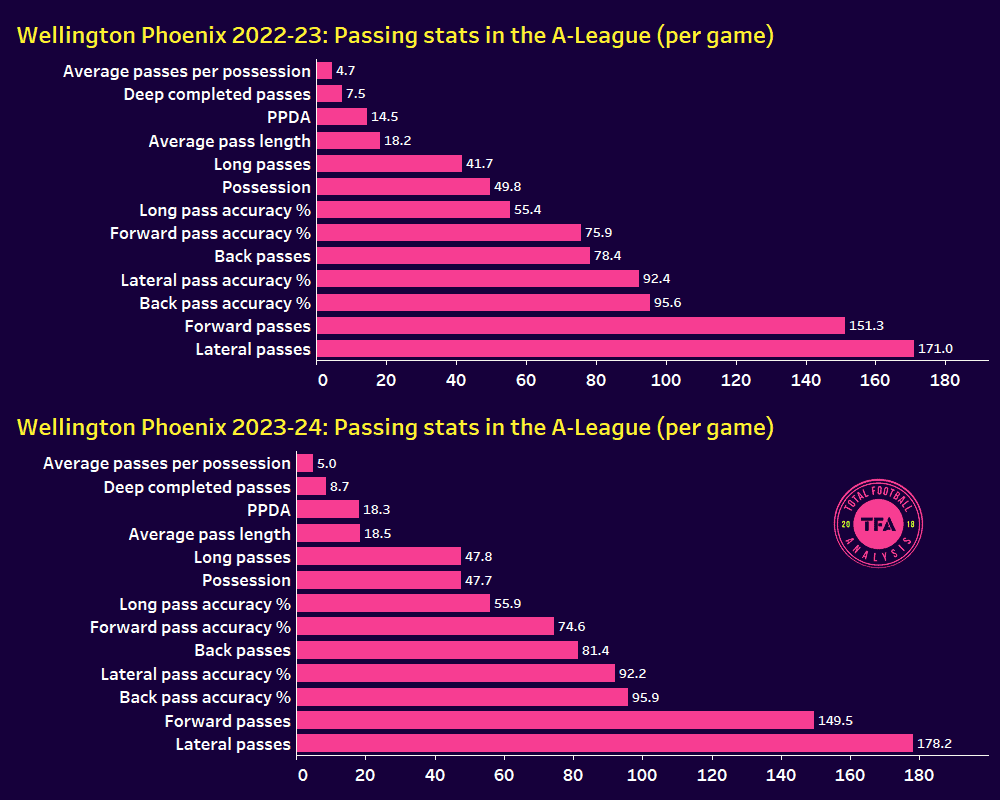
Under Italiano, the Phoenix have slightly improved on passes per possession (5.0 from 4.7) despite a marginal drop in possession (47.7 from 49.8). Their average pass length has also moved up from 18.2 to 18.5, thanks in no part to the massive increase in long passes attempted (47.8 from 41.7). They have also been better with their long passing, completing 8.7 deep passes this term compared to 7.5 last term.
Their forward and backward passing have remained similar, but they are attempting more lateral passes (178.2 from 171.0), which indicates that they could be trying to spread the play more.
However, the biggest indicator of their change in style is their passes per defensive action (PPDA) figure. The Phoenix are averaging 18.3 PPDA this season compared to 14.5 last season, an increase of 20.65%. This means Italiano’s side aren’t voracious pressers; rather, they wait for their opportunity and pounce on it, something that becomes more evident from their chance creation metrics seen below.
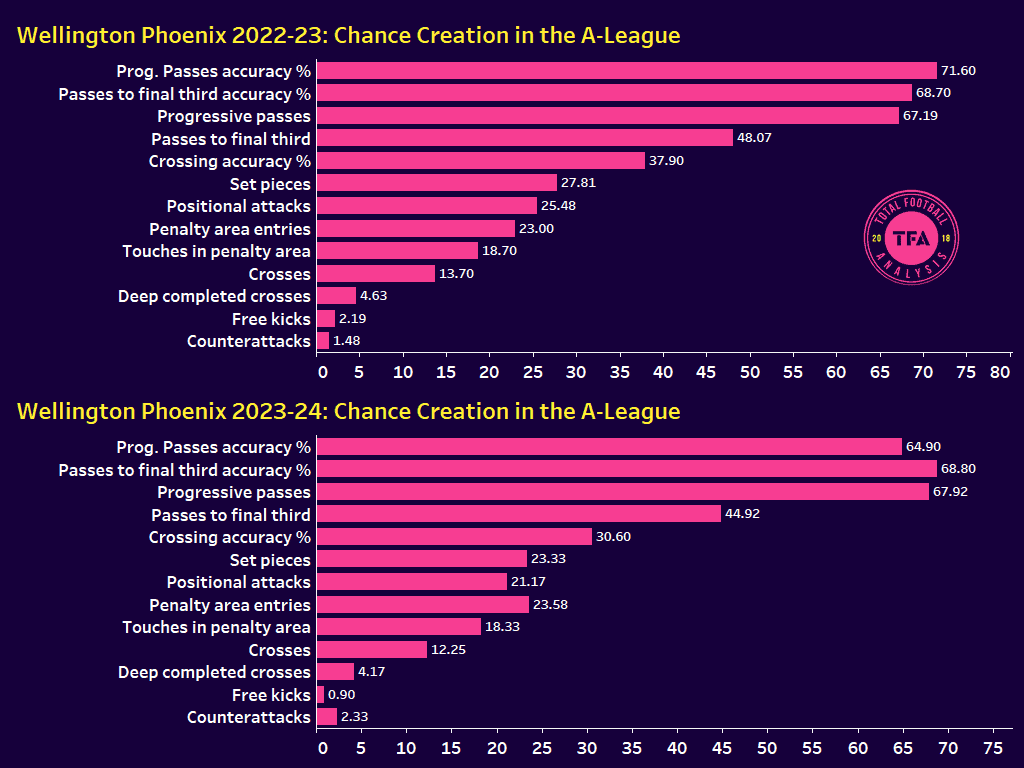
Wellington have made a major improvement in their counterattacks, which have gone up to 2.33 per game this season compared to 1.48 last season. This, in turn, has seen their positional attacks fall from 25.48 to 21.17, while they are also winning fewer set-pieces (23.33 from 27.81).
However, Italiano has helped the Phoenix hold on to a lot of what they were doing well last season. Their progressive passing and final-third entries and passing have only seen marginal changes, while they are also attempting fewer crosses.
Apart from maintaining the status quo in the creation aspect, the Australian manager has improved their potency in attack, which is a major reason they now sit atop the standings.
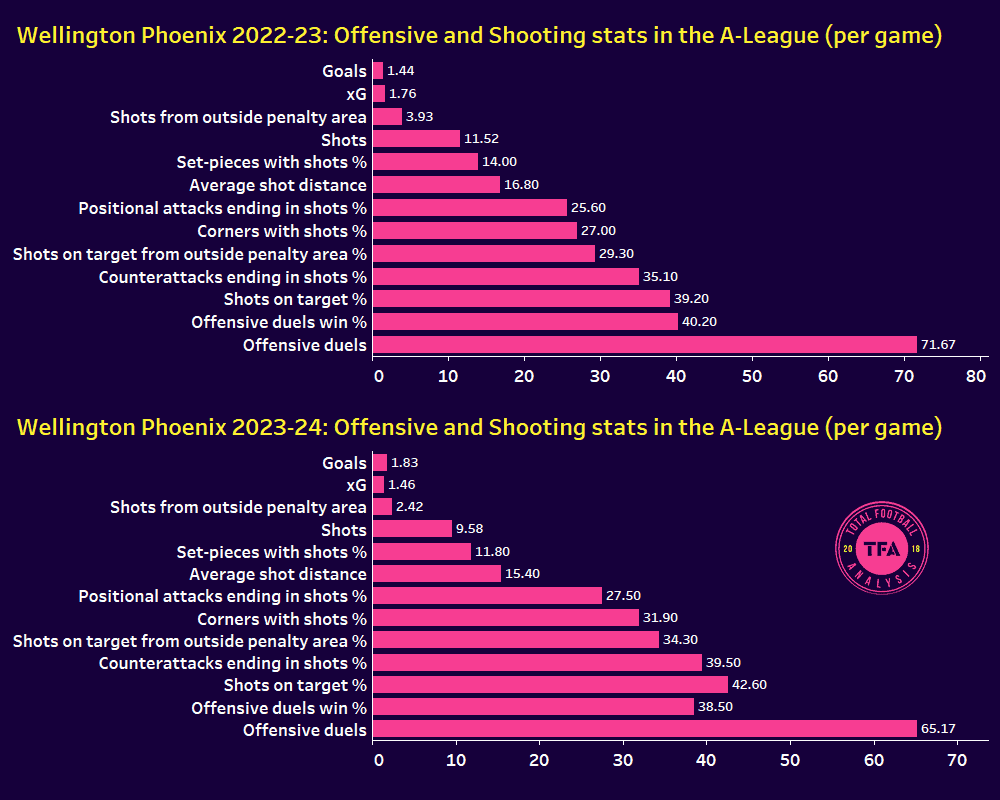
The Phoenix are now shooting from closer to goal (15.40 yards compared to 16.80 last season) and are getting more shots on target (42.6% accuracy from 39.2% last season). More interestingly, a higher percentage of their different forms of attack are all resulting in shots.
Italiano’s men are getting a shot away at the end of 39.5% of their counter-attacks, more than 10% more than last season. In a long campaign, this could prove to be a significant difference-maker.
Even more remarkable is that despite averaging fewer positional attacks and corners, a larger percentage of those end in shots (27.5% from 25.6% and 31.9% from 27.0%, respectively). Additionally, they are getting a higher rate of shots on target from outside the box (34.3% from 29.3% last season).
Despite taking fewer shots (9.58 from 11,52), this collective improvement in diverse types of attacks has held Wellington in good stead. Their only concern in this department could be that they are overperforming their expected goals figure (1.83 goals per game from 1.46 xG). However, given they averaged only 1.44 goals per game last term, their xG figure from this season shows that they are doing better overall.
Their other concern lies in defence, where they struggled considerably last season. The Phoenix have made some improvements in this regard, but there are a couple of worrying trends.
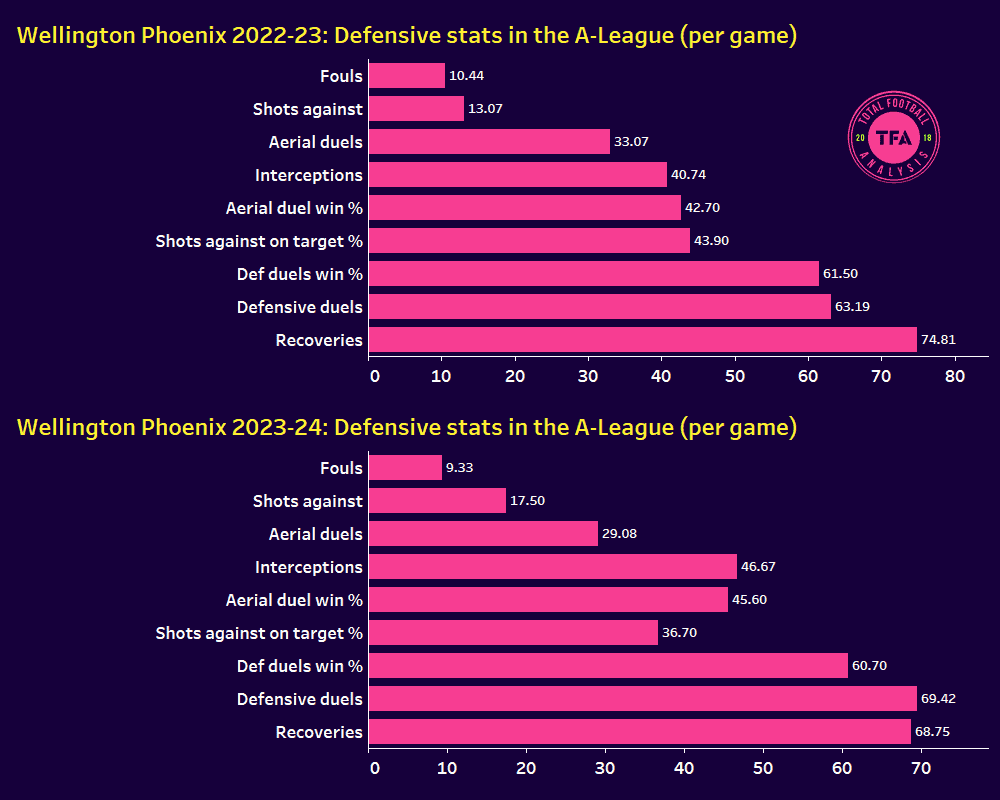
Under Italiano, the Phoenix are giving away fewer fouls (down to 9.33 from 10.44). However, they are allowing more shots (17.50 compared to 13.07). They are also making fewer recoveries despite ceding more possession.
Where they have made improvements, though, is in the quality of chances conceded. Opponents have gotten only 36.7% of their shots on target against Wellington this term, down from 43.9% last season. Additionally, the Phoenix are winning a higher percentage of aerial duels and making more interceptions, often stopping teams at crucial junctures.
All in all, Italiano’s impact, as seen from these statistics, is a positive one, and the A-League leaders certainly merit their spot at the top of the table.
Wellington Phoenix’s playing style in 2023/24
Build-up play
In an interview with Total Football Analysis from August 2020, Italiano, who was in his assistant manager role with the Phoenix at the time, provided insights into the way they set up.
He listed two primary points of focus: a solid defensive foundation, with a few key attributes that led into the second element, i.e., transitions. With this established, they would then analyse the opponent to come up with a game model.
While it has been more than three years since that interview, Wellington’s play this term has built on those foundations to a degree. Italiano’s decision to tweak formations suggests the opponent-based approach, which helps exploit the opposition’s weakness with his players’ strengths.
Firstly, a glance at their heatmap from last season and this one suggests that they are spending more time in their half now than previously. While that can be construed as a shift to a more defensive identity, it could also be the effect of ceding more possession, less intense pressing, and more patient build-up play.

Consider the following sequence from the Phoenix’s draw with Melbourne Victory, where they adopted a 3-4-2-1 shape.
As the ball (marked in white) is circulated among the back three, the central midfielders and one attacking midfielder drop into their own half while the two wing-backs stay high. With the ball on the left and the Victory closely monitoring the midfield trio, the left wing-back comes short to collect it before trying to find an attacker on the left, who is eventually bundled over by his marker.
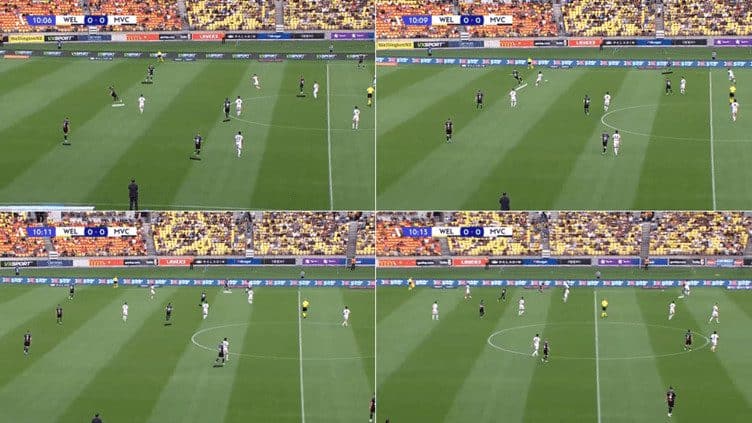
Now, let’s look at a sequence of build-up play from their 4-3 defeat to the Perth Glory, where Italiano opted for a 4-3-3 formation.
In this clip, with the team leading 3-2 midway through the second half, the centre-backs play the ball out to the right. A quick exchange with the right-sided midfielder gives the right-back space to run into and switch the play to the left from where the Phoenix have more options against a backtracking Glory defence.
The formation and opposition pressing style are different, with the latter giving Wellington more space to operate. This lets them play out more quickly, even forming a triangle to facilitate off-the-ball movement that helps circulate the ball more easily. However, a common theme is a third defender dropping back to assist with this circulation while the other full-back is positioned higher up the field.
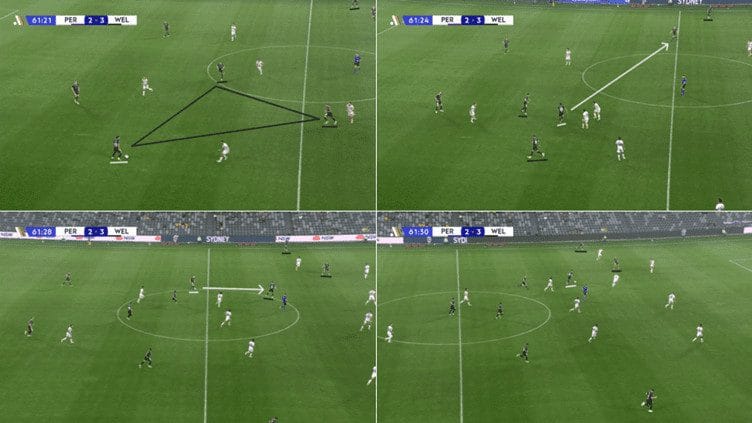
Lastly, here’s a sequence from their 3-0 reverse against the Newcastle Jets, where Italiano adopted a 4-3-2-1 formation. Here, we see a team that needs goals but is also doing a bit of damage control as all four defenders are in their own half, while two of the three central midfielders also drop back. Newcastle’s press is better than Perth’s.
Once again, the quick one-two on the right (white arrow for the pass, black arrow for the run), as we saw earlier, helps the Phoenix march forward and play the ball out wide. The cut-back finds its target, the right-back who initiated the move, but his first-time shot unfortunately cannons back off the post.
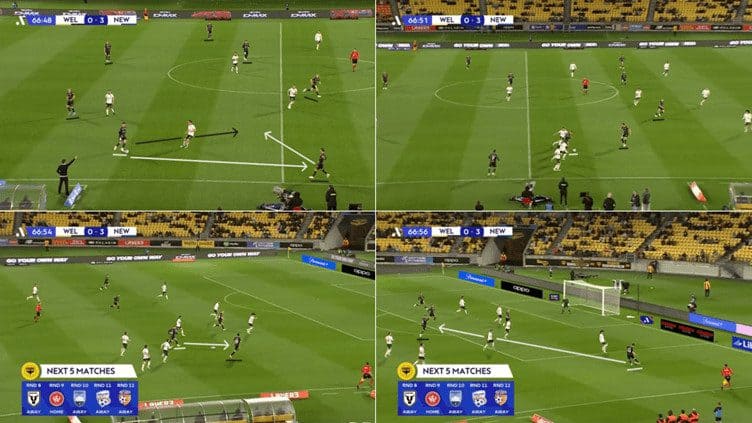
What stands out from all three examples is the use of the full-backs, who provide an outlet for Italiano’s side when needed, regardless of whether they are out wide or in-field. This reduces the burden on the midfielders to create, allowing them to dictate the tempo and get forward into goalscoring positions. It also allows the wingers to move to more central areas to outnumber the defenders in and around the box.
Goals – who’s scoring them and how?
Arguably, the greatest beneficiary from Italiano’s appointment has head coach has been midfielder Barbarouses. In 13 A-League games this season, the Kiwi, who has played across the frontline and as an attacking midfielder, already has eight goals and four assists. He is well on track to beating his best-ever season (14 goals in 27 league games in 18/19).
Besides him, Kraev, who enjoyed a solid 2022/23 season (seven goals and five assists in 25 A-League outings), has continued his excellent form with four goals in 13 appearances. Centre-forward Zawada struck four times in six matches prior to his injury.
As seen in the heatmap above, Phoenix operate marginally more on the right flank in attack than on the left this season. This has helped right-winger Ben Old and right-back Tim Payne, who have scored twice apiece this season. On the other hand, Barbarouses has been Wellington’s most productive outlet on the left, scoring thrice in three league games when played there.
The variety of attributes Barbarouses offers for this Phoenix team can be seen by analysing a couple of his goals. Consider the following sequence from their goalfest against the Perth Glory.
The Phoenix move the ball across the defence before finding David Ball in a bit of space. Ball slips in Barbarouses (marked by the white dash), who smartly alters his run with an excellently weighted through-ball. Barbarouses shows immense composure to take the ball past a tackle, shift it onto his left foot and slightly open his body up, which confuses the goalkeeper, before firing it in at the near-post to make it 1-1.
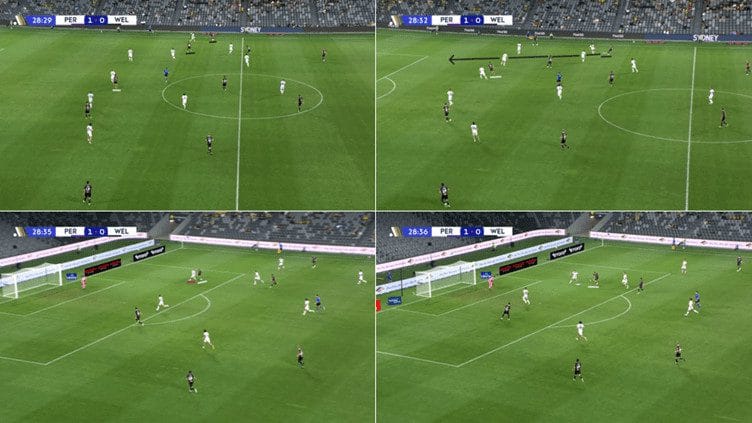
On the counter, one of the Phoenix’s biggest strengths, Barbarouses poses as much danger as he does in positional attacks. In the play below from Wellington’s 3-1 defeat to Sydney FC, the Kiwi does brilliantly to recognise he is in an off-side position when the through ball comes in and curves his run away from the ball.
Oskar van Hattum, who is on-side, latches onto the ball before sliding it to Barbarouses for a tap-in. The move, though, is started by Old winning the ball and gliding past three defenders before playing Van Hattum through.
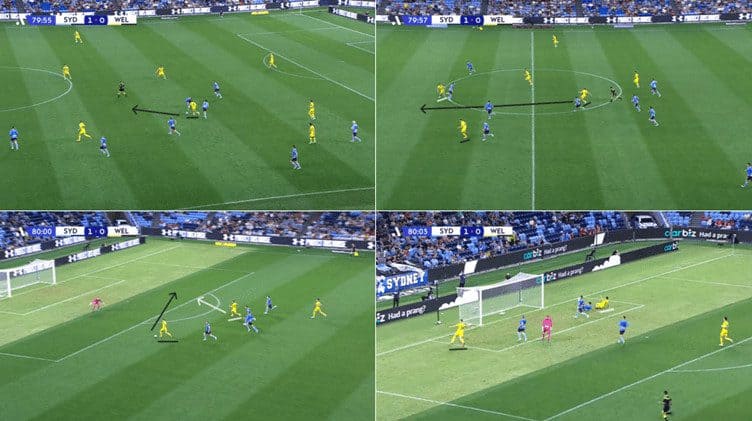
As explained earlier, Old has also delivered the odd goal, such as the one below. This is arguably the best example of Wellington Phoenix’s counter-attacking capabilities this season.
After winning the ball near their own box, they quickly commit numbers to the counter and charge forward. Barbarouses plays a delightful pass between the two retreating defenders to find Old (marked in white), who has charged forward from his own box to support the counter, on the left. He takes a first-time effort that lashes across the goalkeeper and into the back of the net with precision.
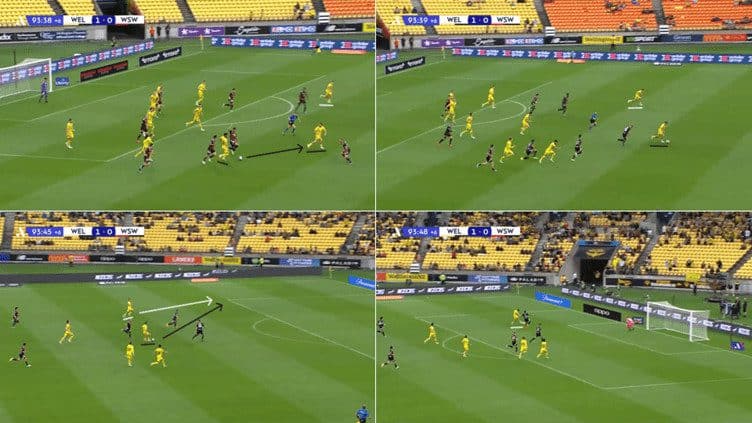
Lastly, glancing at Kraev’s goals also explains how he fits into Italiano’s offensive scheme. The first, which came in a 3-0 win over Macarthur, is the product of some excellent build-up play, with Old (white) first collecting the ball from the defence in his own half. He skips past a defender, finds Barbarouses and then runs off the back of a defender, giving him little time to react.
Barbarouses, identifying the run, slips the ball back to Old, and his first-time cutback is tapped in by Kraev at the far post.
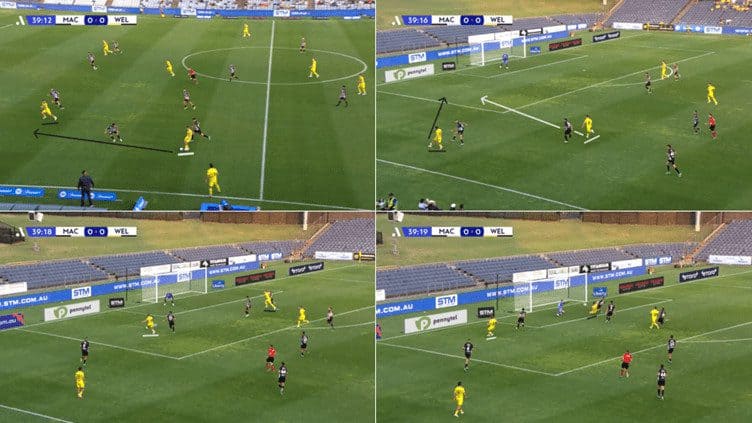
The second is on a counter as the Phoenix win the ball close to their halfway line. Barbarouses is heavily involved again, getting past two defenders before finding Zawada, who lays it off to Kraev (marked in white). He runs onto the ball and hits it first time past the goalkeeper.
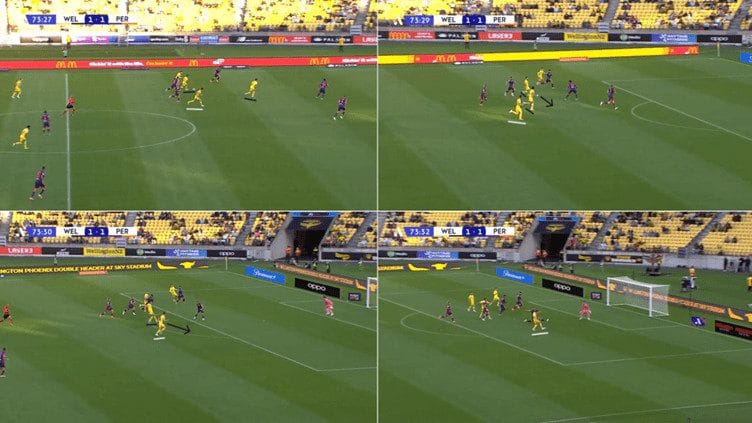
Defending: Wellington Phoenix have improved but need to do more
The last aspect this report will look at is Wellington Phoenix’s defensive set-up this season. Once again, the variety in formations gives us multiple different schemes to look at.
As evident from previously in this piece and their defensive territory map below, the Phoenix are operating from slightly deeper, their pressing is a little less intense, but there seems to be a greater emphasis on closing spaces down, while many of their defensive metrics have improved.
Their defensive actions and interceptions are also more concentrated near their own box, while both aspects, as well as fouls, have reduced in quantity in the final third compared to last season. This, once again, results from the fact that they are not pressing as high as before and are sitting a little deeper, giving them a more solid defensive shape.
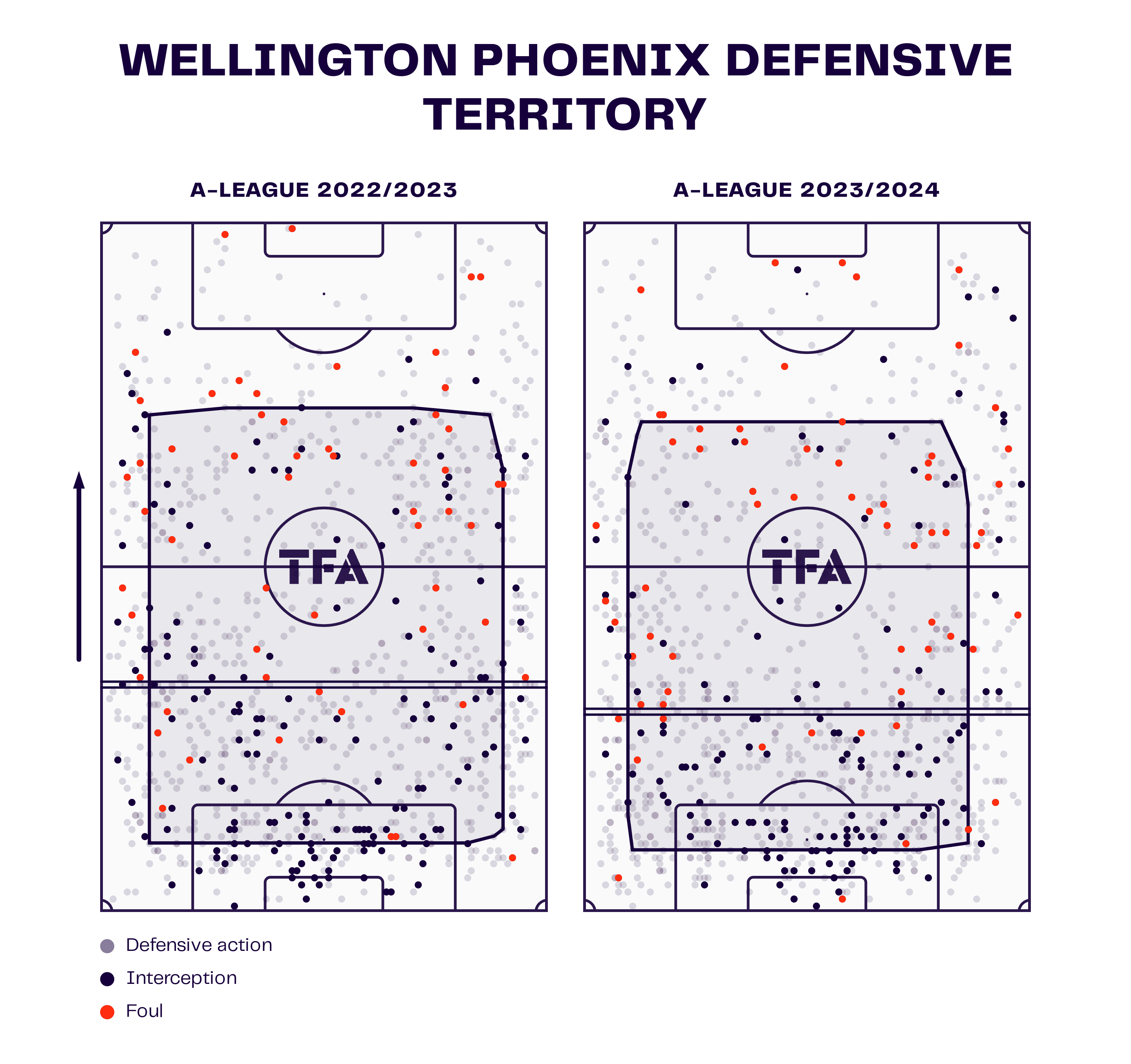
Last season, Wellington kept only five clean sheets in 26 A-League games. They have already managed that many only halfway through the ongoing campaign, though a couple of their games have been shootouts with seven goals across both teams.
This leads into one of the areas Italiano’s men have struggled in at times: their start to halves. Out of the 16 league goals they have conceded this term, nine have come within 15 minutes of the start of either half (four between 1’ and 15’, and five between 46’ and 60’).
The other concern involves their reaction to quick passing moves. Wellington’s defence has been caught flat-footed at times.
Both these elements can be seen in play in the following sequence from their 3-0 defeat to the Newcastle Jets, who scored in the fourth minute of the game.
Failure to close down a defender soon enough allows him to play it out wide. In this case, the Phoenix’s right-back fails to read the impending danger and enables the opposing left-back to play his winger in with a ball in behind. The Jets winger makes his way into the box, and a couple of half-hearted Phoenix challenges are to no avail as he finds a teammate close to the penalty spot and scores on the turn to make it 1-0.
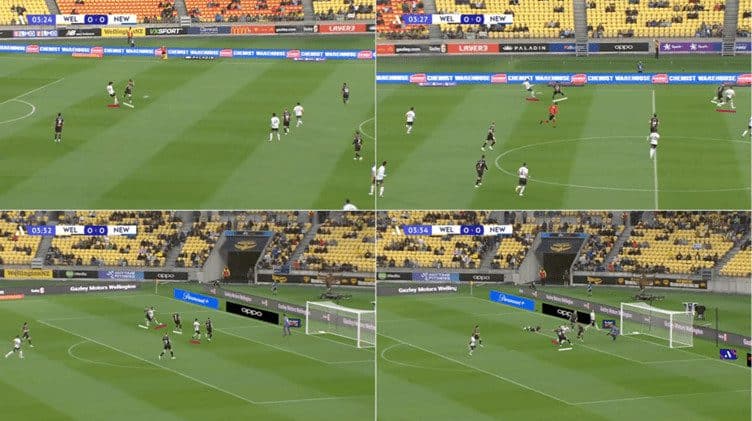
Another example of such a lapse comes in their 5-2 win over the Brisbane Roar. This time around, the Phoenix conceded in the very first minute following a harmless ball over the top. Once again, one of their full-backs (on the left this time) is a little lackadaisical and allows the winger to get behind. The latter then cuts back to find a teammate infield.
Rather uncharacteristically, three Phoenix players go to close down the opponent, leaving a player unmarked (marked in black) on the edge of the area. The Roar player plays the smart pass to find his unmarked teammate, who takes a touch to get away from a defender and rifles a shot into the back of the net.

While these are examples of where the shape has been pulled apart, there have been numerous occasions where Wellington’s defence has held its own without pressing their opponents. Consider the following sequence from their match against Adelaide United, split into two individual cases.
In the first case, the Phoenix let Adelaide have the ball, applying no pressure to their back four and instead attempting to close down spaces in midfield. Meanwhile, behind their three-man triangular frontline, two lines of three and four further limit the avenues for the opponent. United are thus limited to lateral and back-passing, while their only forward passes go to midfielders who are turned towards the defence and can’t progress the ball forward.
Wellington seem to have them trapped, but it becomes vaguely clear in the bottom-right tile that Adelaide have figured out an opening as the first triangle breaks down…
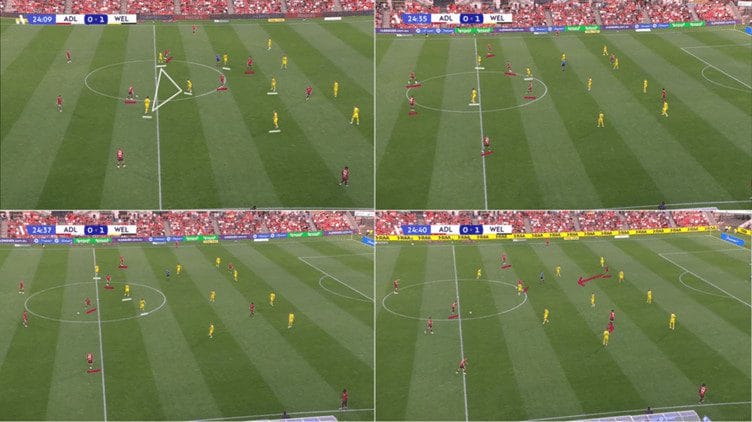
This leads us into the second phase of this sequence, as the holding midfielder plays the ball to the forward, who comes short. Suddenly, Adelaide has more avenues and work the ball out wide to their right-winger, who has space. However, Wellington respond brilliantly to double up and limit the space for him and force him to the by-line from where he can’t send in a dangerous ball.
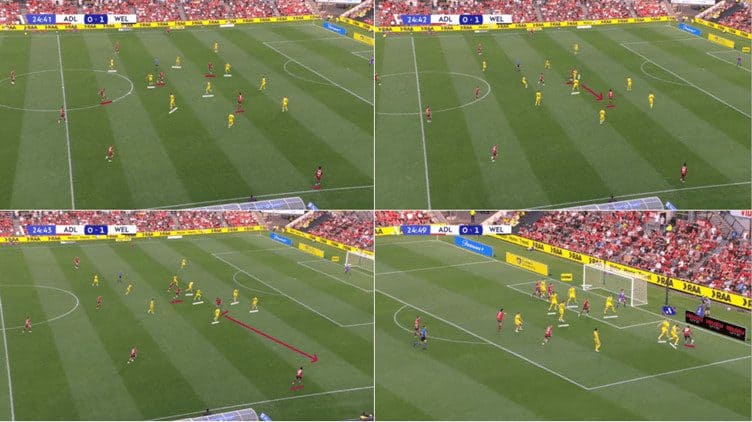
What stands out here is Wellington’s collective response to danger. When Adelaide break through the initial press, they immediately have more pockets to operate in. However, by the time they get in and around the box, the Phoenix have multiple players back. In the bottom-right frame above, nine yellow shirts are in the box compared to six red ones.
That indicates that when settled into a shape and focused, Italiano’s men can be tough to break down. If they get rid of the odd lapse in concentration at the start of halves, this would certainly be a more robust defensive side.
Conclusion
Giancarlo Italiano has enjoyed massive short-term success with Wellington Phoenix this term. His side are attacking more efficiently, particularly on the counter. While that may not be considered beautiful by purists, it is effective and has led to some show-stopping passing moves that have resulted in goals.
Defensively, the Phoenix do have some work to do, but they have already taken significant strides from last season. With more time on the training ground under Italiano, who is getting his message across and has undoubtedly helped maximise the potential of key players, the expectation would be for them to improve further while maintaining their attacking potency.

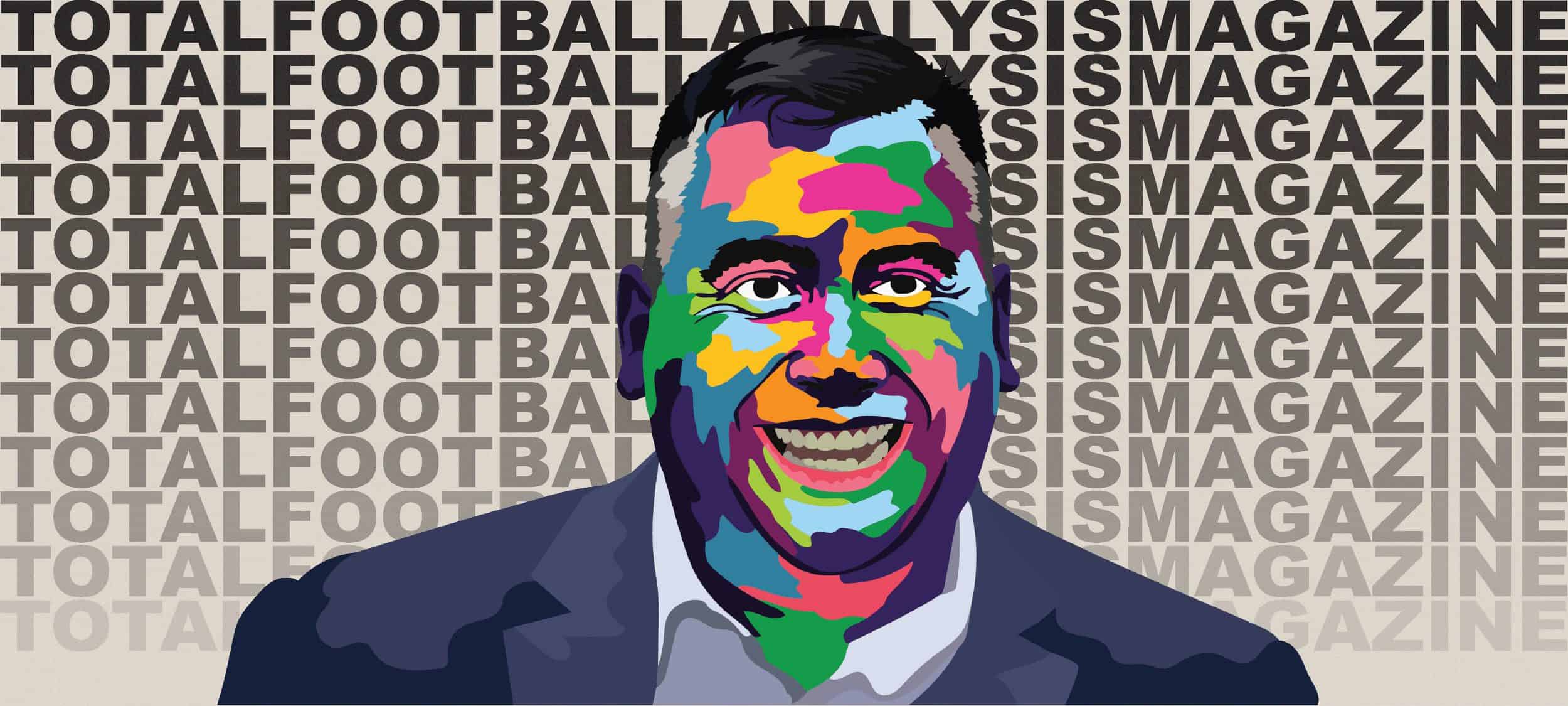



Comments